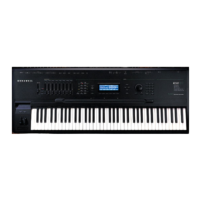Program Edit Mode
Arpeggiator Page
3-12
Arpeggiator Page
Use the Arpeggiator page to adjust settings for the Program’s Arpeggiator. e Arpeggiator
takes note input from the keyboard (or via MIDI) and outputs a rhythmic and/or melodic
pattern of MIDI notes. e Arpeggiator can aect both the internal programs and external
MIDI instruments.
e Arpeggiator processes notes by playing them repeatedly, and/or transposing them
up and down the keyboard. You have control over note output velocity, order, duration,
transposition, and more. In Multi Mode, you can assign controllers to control several
arpeggiator parameters in real time (see Multi Controller destinations 147, 150-160 and
170-178 in Controller Destination List on page 5-31). You can also select and edit patterns
for note shifting, velocity shifting, and duration, either as independent patterns, or as a
combination of all three in Step Sequencer mode. e Arpeggiator also has several dierent
“latch” settings, which allows the arpeggiator to respond to played notes in dierent ways,
such as continuing to play after you have released the keys.
Arpeggiator Common Parameters
e following common parameters are used by the Arpeggiator in both Classic and Step
Sequencer mode.
Arp Preset
Use the Arp Preset parameter to recall factory or user created Arpeggiator settings. An Arp
Preset contains settings for all of the parameters on the Arpeggiator page (except for the State
and Key Range parameters, which are stored with the Program/Multi). Scrolling through the
Arp Presets is an easy way to discover the dierent possibilities of the arpeggiator, or to nd a
preset similar to what you want and continue to edit it from there.

